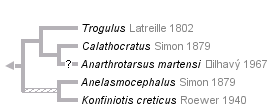Trogulidae
Axel Schönhofer


This tree diagram shows the relationships between several groups of organisms.
The root of the current tree connects the organisms featured in this tree to their containing group and the rest of the Tree of Life. The basal branching point in the tree represents the ancestor of the other groups in the tree. This ancestor diversified over time into several descendent subgroups, which are represented as internal nodes and terminal taxa to the right.

You can click on the root to travel down the Tree of Life all the way to the root of all Life, and you can click on the names of descendent subgroups to travel up the Tree of Life all the way to individual species.
For more information on ToL tree formatting, please see Interpreting the Tree or Classification. To learn more about phylogenetic trees, please visit our Phylogenetic Biology pages.
close boxIntroduction
The Trogulidae are a Western Palearctic family of soil-dwelling harvestmen with advanced soil crypsis and a very uniform appearance. Body shape is elongated and dorso-ventrally compressed. In Anelasmocephalus and Konfiniotis it is more drop-shaped. All species exhibit a more or less prominent head cap consisting of bifurcated branches that shield the chelicerae dorsally. The body and the legs are covered with rounded papillae, partly set with bristles, and particles are glued between these by body secretion, giving the animals the appearance of a piece of soil. Movement is slow, and they are hard to find as they rarely move when disturbed. Most species seem to prey on snails, and Trogulus has been observed to deposit its eggs in empty snail shells (Pabst 1953).
Taxonomy and Discussion of Phylogenetic Relationships
Based on molecular phylogenetic analysis there is weak support for a grouping of the drop-shaped Anelasmocephalus and Konfiniotis but strong support for grouping the remaining flat-bodied taxa. The genus Anarthrotarsus was not available for this analysis but most likely belongs to the latter group as well, based on the similar body form. The number of taxa within Trogulidae is highly underestimated due to the homogeneous external morphology. Revisions are tedious, and necessitate incorporation of multiple traits from molecular data and morphology, requiring extensive material available for delineation of morphological units (Schönhofer & Martens 2010).
References
Pabst, W. 1953. Zur Biologie der mitteleuropäischen Troguliden. Zoologische Jahrbücher. Abteilung für Systematik, Geographie und Biologie der Tiere 82:1-46.
Schönhofer, A. L. and J. Martens 2010. Hidden Mediterranean diversity: Assessing species taxa by molecular phylogeny within the opilionid family Trogulidae (Arachnida, Opiliones). Molecular Phylogenetics and Evolution 54 (1):59-75.
Title Illustrations

| Scientific Name | Trogulus tingiformis |
|---|---|
| Specimen Condition | Live Specimen |
| Identified By | Axel Schoenhofer |
| Sex | f |
| Life Cycle Stage | adults |
| Copyright |
© 2011 Axel Schönhofer

|
| Scientific Name | Anelasmocephalus hadzii |
|---|---|
| Specimen Condition | Live Specimen |
| Identified By | Axel Schoenhofer |
| Sex | m |
| Life Cycle Stage | adult |
| Copyright |
© 2011 Axel Schönhofer

|
About This Page
Many thanks to Dave Carlson for the final English check.
Axel Schönhofer

San Diego States University, San Diego, California, USA
Correspondence regarding this page should be directed to Axel Schönhofer at
Page copyright © 2013 Axel Schönhofer
 Page: Tree of Life
Trogulidae .
Authored by
Axel Schönhofer .
The TEXT of this page is licensed under the
Creative Commons Attribution-NonCommercial License - Version 3.0. Note that images and other media
featured on this page are each governed by their own license, and they may or may not be available
for reuse. Click on an image or a media link to access the media data window, which provides the
relevant licensing information. For the general terms and conditions of ToL material reuse and
redistribution, please see the Tree of Life Copyright
Policies.
Page: Tree of Life
Trogulidae .
Authored by
Axel Schönhofer .
The TEXT of this page is licensed under the
Creative Commons Attribution-NonCommercial License - Version 3.0. Note that images and other media
featured on this page are each governed by their own license, and they may or may not be available
for reuse. Click on an image or a media link to access the media data window, which provides the
relevant licensing information. For the general terms and conditions of ToL material reuse and
redistribution, please see the Tree of Life Copyright
Policies.
- First online 03 April 2013
- Content changed 03 April 2013
Citing this page:
Schönhofer , Axel. 2013. Trogulidae . Version 03 April 2013 (temporary). http://tolweb.org/Trogulidae/60694/2013.04.03 in The Tree of Life Web Project, http://tolweb.org/





 Go to quick links
Go to quick search
Go to navigation for this section of the ToL site
Go to detailed links for the ToL site
Go to quick links
Go to quick search
Go to navigation for this section of the ToL site
Go to detailed links for the ToL site